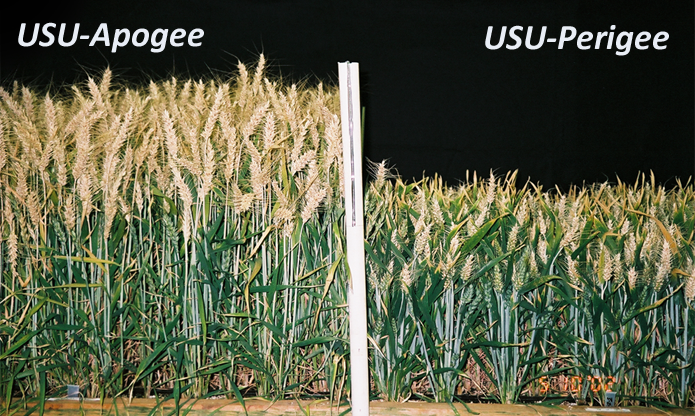Dwarf Crops For Space Flight
With funding from NASA and the Utah Agricultural Experiment Station, the Crop Physiology Laboratory researches the challenges associated with growing food crops in bioregenerative life support systems in space.
 USU-Apogee Wheat is the first crop developed specifically to grow in space where the light “sun” can shine 24 hours, where roots never touch soil, and room to grow is at a premium. USU-Apogee (named for the point in an orbit farthest from the Earth) was successfully grown aboard the International Space Station from April to June 2003, thriving in the unusual conditions because its seed heads emerge just 23 days after germination and it is only 40 cm (16 inches) tall, about half the height of terrestrial wheat. This variety was followed by the related USU-Perigee Wheat (named for the point in an orbit closest to the Earth).
USU-Apogee Wheat is the first crop developed specifically to grow in space where the light “sun” can shine 24 hours, where roots never touch soil, and room to grow is at a premium. USU-Apogee (named for the point in an orbit farthest from the Earth) was successfully grown aboard the International Space Station from April to June 2003, thriving in the unusual conditions because its seed heads emerge just 23 days after germination and it is only 40 cm (16 inches) tall, about half the height of terrestrial wheat. This variety was followed by the related USU-Perigee Wheat (named for the point in an orbit closest to the Earth).
Other research and/or testing has been done with Micro-Tina tomatoes, Super Dwarf rice, Hoyt soybeans, Triton peppers and Earligreen peas.
Publications
- Elevated Atmospheric Ethylene and High Temperature Independently Inhibit Fruit Set But Not Vegetative Growth in Tomato, Timothy J. Hudelson, F. Mitchell Westmoreland, and Bruce Bugbee
- ‘Earligreen’ a Super-Dwarf Pea Cultivar for Use in Controlled Environment Research, Joseph F. Romagnano, Emily Mills, and Bruce Bugbee
- Instructions for Growing Dwarf Crop Plants Under Electric Lights, Bruce Bugbee
- Temperature Sensitivity of Four Tomato Cultivars, Jonathan M. Frantz, Justin Robinson, and Bruce Bugbee
- Dwarf Crop Response to a 16 or 24 hr Photoperiod Under Low-Light Conditions, Joseph F. Romagnano, Emily Mills, and Bruce Bugbee
- Dwarf Peppers: Evaluation of ‘Triton’, USU Crop Physiology Lab
- Historical Summary of the Selection of USU-Perigee, USU Crop Physiology Lab
- Summary Data from Five Years of Dwarf Wheat Yield Trials, USU Crop Physiology Lab
- Anaerobic Conditions Improve Germination of a Gibberellic Acid Deficient Rice, Jonathan Frantz and Bruce Bugbee
- Response of Micro-Tom to Low Light, Jonathan M. Frantz, Justin Robinson, and Bruce Bugbee
- Plant Deficiencies and Toxicities of Soybean and Sunflower, USU Crop Physiology Lab
- Yield Comparisons and Unique Characteristics of the Dwarf Wheat Cultivar 'USU-Apogee', Bruce Bugbee and G. Koerner
- 'USU-Apogee' Wheat - Registration, Bruce Bugbee, G. Koerner, R. Albrechtsen, W. Dewey, and S. Clawson
- Unique Procedures for Germinating 'Super Dwarf' Rice, Jonathan Frantz and Bruce Bugbee
- 'Super Dwarf' Rice: Temperature Studies, Steve Klassen and Bruce Bugbee
- Utah State University Develops Space Crop, NASA

